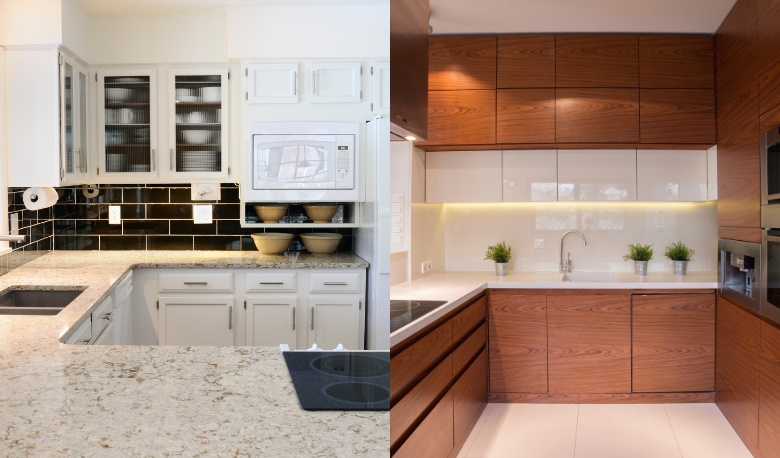Microwaves are a staple in most kitchens, but countertop space can be precious. If you’re wondering if placing your microwave inside a cabinet is a good solution, the answer is yes – but with careful planning and consideration. This guide will explore the pros, cons, safety factors, and different ways to integrate a microwave into your cabinetry for a seamless and functional kitchen design.
Understanding Types of Microwaves
Before we dive into cabinet placement, let’s understand the common types of microwaves:
- Countertop microwaves: The most familiar type, designed to sit on a countertop.
- Over-the-range microwaves: Mounted above the stove, freeing up counter space and often including a built-in ventilation system.
- Built-in microwaves: Designed specifically for integration into cabinetry, offering a sleek, custom look.
- Microwave drawers: Slide-out microwave units installed beneath countertops or within kitchen islands, ideal for accessibility.
Can All Microwaves Go in Cabinets?
It’s crucial to note that not all microwaves are suitable for cabinet installation. Countertop microwaves require open airflow around them and enclosing them in a cabinet creates a potential fire hazard. Only microwaves that are specifically designed as built-in models or microwave drawers are meant for cabinet integration.
Pros and Cons of Putting a Microwave in a Cabinet
Let’s weigh the advantages and potential drawbacks of integrating a microwave within cabinetry:
Pros
- Frees up Counter Space Embedding a microwave within your cabinetry eliminates countertop clutter, a real blessing in kitchens where space is limited. This provides more surface area for food preparation, small appliances, or simply creates a more open feel.
- Sleek, Integrated Look A microwave incorporated into your cabinets blends seamlessly with your kitchen’s overall design. This contributes to a more polished and high-end appearance, free from appliances that can look out of place on countertops.
- Convenience Depending on your kitchen’s design, incorporating your microwave into cabinetry can create a more convenient cooking workflow. The ideal placement and height can make it easier to transfer food in and out, potentially reducing spills or accidents if counter space is limited.
Cons
- Installation Cost Retrofitting a cabinet to accommodate a microwave often requires professional help from a carpenter or kitchen remodeler. This expense needs to be factored into your decision. Additionally, built-in microwave models designed for cabinet installation tend to be slightly more expensive than their countertop equivalents.
- Accessibility Cabinets positioned too high could become difficult to reach for children or individuals with limited mobility. When considering in-cabinet microwaves, think about who will be using it regularly and place it at an appropriate height.
- Ventilation Requirements Microwaves nestled within cabinets or drawers require sufficient space around them for proper ventilation. Overheating could shorten your appliance’s lifespan or create safety hazards. Be sure to follow the manufacturer’s recommended clearances for your chosen microwave model.
Safety Considerations for Cabinet Microwave Installation
Putting a microwave in a cabinet offers a sleek and space-saving solution, but prioritizing safety throughout the installation process is absolutely essential. Here’s what you need to keep in mind:
-
Professional installation
Unless you possess extensive experience in electrical wiring and carpentry, it’s safest to hire a qualified electrician or kitchen installer. They can accurately assess your electrical capacity, modify cabinets as needed, and ensure the microwave is correctly wired and secured. This minimizes the risk of electrical hazards and installation errors that could lead to damage or even fire.
-
Manufacturer’s instructions
Every microwave model, whether built-in or a microwave drawer, comes with specific installation instructions. These instructions detail the exact clearances required around the appliance for proper ventilation, as well as any specific electrical requirements. Adhering to these instructions is crucial to prevent overheating and potential malfunctions.
-
Appropriate clearances
Even with a correctly installed built-in microwave, you need to make sure there’s enough open space around the unit to allow for airflow and heat to escape. The manufacturer’s instructions will provide these specific measurements. Overcrowding the microwave within tight cabinet space creates a fire hazard.
-
Dedicated circuit
Depending on your existing electrical layout and the power consumption of your microwave, a dedicated circuit might be necessary. A qualified electrician can advise if this is required. A dedicated circuit ensures the microwave has sufficient power without overloading other outlets or appliances, preventing potential power surges and electrical issues.
Remember: Safety should always come first. Investing in professional installation and meticulously following all guidelines will ensure a smoothly functioning and, most importantly, safe kitchen for you and your family.
Stylish Ways to Integrate a Microwave into Your Cabinets
Beyond freeing up counter space, there are several stylish ways to seamlessly incorporate a microwave into your kitchen design:
Cabinet Shelf: This is the most straightforward approach. Designate a cabinet with a strong, reinforced shelf to house your built-in microwave. Ensure the shelf depth can accommodate the appliance and that there’s a power outlet within easy reach. Ideal for those who don’t require additional trim or concealment.
Trim Kit: Many manufacturers of built-in microwaves offer matching trim kits. These kits create a framed, finished appearance around the microwave, giving it a truly integrated, custom-built look that blends seamlessly with your cabinetry.
Microwave Drawer: Microwave drawers are a contemporary and sleek choice. These units slide out smoothly, offering convenient access to the microwave’s interior. They’re perfect for installation under countertops, within kitchen islands, or within lower base cabinets. Keep in mind, microwave drawers tend to be on the pricier side.
Appliance Garage: If you prefer the option to conceal your microwave when not in use, consider installing an “appliance garage.” This is a section of your upper cabinets fitted with a door that disguises the appliance. Roll-top “tambour” doors or pocket doors that slide back into the cabinet are excellent choices, allowing for easy concealment and access to the microwave.
Important Considerations Before You Decide
- Microwave size and cabinet dimensions: Measure carefully! Ensure your chosen built-in microwave or drawer model fits the cabinet space, including ventilation requirements.
- Cabinet material: Cabinets must be able to withstand the weight of the appliance and a certain amount of heat.
- Electrical wiring: Determine if you need new wiring or modifications to existing circuits.
- Accessibility: Think about who’ll use the microwave and if the cabinet height is convenient for everyone.
FAQs – Addressing Common Concerns
Q: Will putting my microwave in a cabinet damage it?
A: Only if it’s a countertop model or the built-in microwave isn’t installed correctly with proper ventilation. Countertop microwaves require open airflow to function safely.
Q: Is it okay to put a microwave above the stove?
A: Over-the-range microwaves are specifically designed for this purpose and often include built-in exhaust fans for stovetop ventilation, making them a space-saving solution.
Q: Can I put a regular microwave in a cabinet if I leave the door open?
A: No. Even with the cabinet door open, there won’t be adequate airflow and heat dissipation to prevent the countertop microwave from overheating.
Q: Are microwave drawers a good option?
A: Microwave drawers offer ergonomic access and a sleek aesthetic, especially for kitchen islands or under-counter installation. However, they tend to be more expensive than built-in microwaves.
Q: Is it difficult to install a built-in microwave?
A: The complexity depends on your cabinets and electrical setup. If your cabinets and wiring are ready, it may be a relatively simple process. However, if cabinet modifications and new electrical circuits are needed, professional installation is best.
Conclusion
Integrating a microwave into your cabinetry can be a fantastic way to optimize kitchen space and enhance its design. If you plan carefully, ensure proper ventilation and installation, and choose the right type of microwave, you’ll enjoy a functional, safe, and stylish kitchen for years to come.




